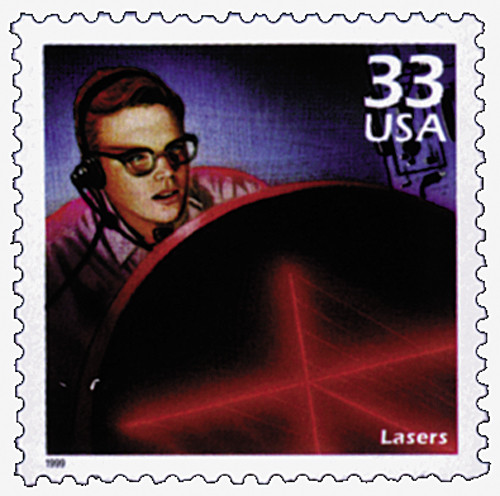
1999 33c Celebrate the Century,1960s: Lasers
# 3188k - 1999 33c Celebrate the Century - 1960s: Lasers
$1.95 - $3.20
U.S. #3188k
33¢ Lasers
Celebrate the Century – 1960s
33¢ Lasers
Celebrate the Century – 1960s
Issue Date: September 17, 1999
City: Green Bay, WI
Quantity: 8,000,000
Printing Method: Lithographed, engraved
Perforations: 11.5
City: Green Bay, WI
Quantity: 8,000,000
Printing Method: Lithographed, engraved
Perforations: 11.5
The laser is a device that produces an intense beam of light that is a very pure, single color. The beam can be intense enough to melt the hardest and most heat-resistant metals. The word laser is an acronym for the phrase “light amplification by stimulated emission of radiation.”
Einstein recognized the existence of stimulated emission as early as 1916, but it wasn’t until the 1950s that the principles were put to use. American scientists Charles Townes and Arthur Schawlow were responsible for completing much of the initial research on the laser during this time. The first laser, constructed by Theodore Maiman in 1960, used a ruby crystal. In 1964, Townes and two other scientists were awarded a Nobel Prize in physics for the development of the laser.
The light produced by lasers is far more directional and powerful than that from any other source. Lasers have measured the distance from the Earth to the moon with a reported accuracy of about one foot. A laser directed from an airplane can be used for mapping the steps in a stadium or the shape of a roof on a house.
One of the first medical procedures to utilize the laser was for surgery on the retina of the eye. As research is completed, laser surgery on other areas of the body is becoming more common.
U.S. #3188k
33¢ Lasers
Celebrate the Century – 1960s
33¢ Lasers
Celebrate the Century – 1960s
Issue Date: September 17, 1999
City: Green Bay, WI
Quantity: 8,000,000
Printing Method: Lithographed, engraved
Perforations: 11.5
City: Green Bay, WI
Quantity: 8,000,000
Printing Method: Lithographed, engraved
Perforations: 11.5
The laser is a device that produces an intense beam of light that is a very pure, single color. The beam can be intense enough to melt the hardest and most heat-resistant metals. The word laser is an acronym for the phrase “light amplification by stimulated emission of radiation.”
Einstein recognized the existence of stimulated emission as early as 1916, but it wasn’t until the 1950s that the principles were put to use. American scientists Charles Townes and Arthur Schawlow were responsible for completing much of the initial research on the laser during this time. The first laser, constructed by Theodore Maiman in 1960, used a ruby crystal. In 1964, Townes and two other scientists were awarded a Nobel Prize in physics for the development of the laser.
The light produced by lasers is far more directional and powerful than that from any other source. Lasers have measured the distance from the Earth to the moon with a reported accuracy of about one foot. A laser directed from an airplane can be used for mapping the steps in a stadium or the shape of a roof on a house.
One of the first medical procedures to utilize the laser was for surgery on the retina of the eye. As research is completed, laser surgery on other areas of the body is becoming more common.










